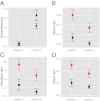House-to-house human movement drives dengue virus transmission
- PMID: 23277539
- PMCID: PMC3549073
- DOI: 10.1073/pnas.1213349110
House-to-house human movement drives dengue virus transmission
Abstract
Dengue is a mosquito-borne disease of growing global health importance. Prevention efforts focus on mosquito control, with limited success. New insights into the spatiotemporal drivers of dengue dynamics are needed to design improved disease-prevention strategies. Given the restricted range of movement of the primary mosquito vector, Aedes aegypti, local human movements may be an important driver of dengue virus (DENV) amplification and spread. Using contact-site cluster investigations in a case-control design, we demonstrate that, at an individual level, risk for human infection is defined by visits to places where contact with infected mosquitoes is likely, independent of distance from the home. Our data indicate that house-to-house human movements underlie spatial patterns of DENV incidence, causing marked heterogeneity in transmission rates. At a collective level, transmission appears to be shaped by social connections because routine movements among the same places, such as the homes of family and friends, are often similar for the infected individual and their contacts. Thus, routine, house-to-house human movements do play a key role in spread of this vector-borne pathogen at fine spatial scales. This finding has important implications for dengue prevention, challenging the appropriateness of current approaches to vector control. We argue that reexamination of existing paradigms regarding the spatiotemporal dynamics of DENV and other vector-borne pathogens, especially the importance of human movement, will lead to improvements in disease prevention.
Conflict of interest statement
The authors declare no conflict of interest.
Figures




References
Publication types
MeSH terms
Grants and funding
LinkOut - more resources
Full Text Sources
Medical

